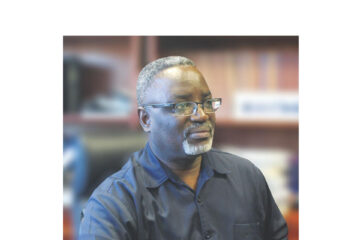Josef Kefas Sheehama
Given the potential for the blue economy to generate a significant number of direct and indirect jobs, Namibia has a great chance for long-term economic growth and development. The NDP 5 interventions can also be utilized to realize Namibia’s Vision 2030 aspirations of eradicating poverty, decreasing inequality, and fostering an inclusive economy.
Namibia must revive, implement robust climate change mitigation strategies, and maintain an eco-friendly economy that generates employment to preserve the ecosystems. The country will thereafter be able to effectively combat climate change. The green economy is defined by the United Nations Environment Programme (UNEP) as a low-carbon, resource-efficient, and socially inclusive economy.
Green growth is defined by the Organization for Economic Co-operation and Development as promoting economic growth and development while ensuring that natural assets continue to provide the resources and environmental services that are essential to our well-being. Given the significance of the global climate crisis, the green economy seems to be the most viable solution for the prevailing economic model and is essential to attaining sustainable development, particularly in developing nations like Namibia.
Furthermore, in terms of the Fifth National Development Plan (NDP 5), the Green Economy seeks to develop and broaden the Blue Economy in order to foster social inclusion, sustainable production, and equitable wealth distribution while maintaining environmental health. While resource efficiency refers to the ways in which resources are used to deliver value to society and aims to reduce the amount of resources needed. With an emphasis on investments, jobs, and skills, the Green Economy offers a macroeconomic strategy for long-term, sustainable economic growth. Therefore, the steps that need to be taken by governments and other stakeholders to address these barriers are those that the blue economy strategy should identify.
Government measures should encourage domestic aquaculture production, such as the use of earth dams and strict regulations, as these are essential for the establishment of a commercial aquaculture industry and can help reduce unemployment. The Epalela fish farm has to be revitalized and upgraded by the government to raise food security, provide jobs, and raise the level of living in the surrounding communities. In Epalela, there is one irrigation pond, nine concrete ponds, and two earth ponds. Namibia has a lot of earth dams that the government may help improve and make available to the locals as a cooperative to catch fish for the local hospitals, schools, and retail stores. In Namibia, floodwater that came from the Cuvelai can be collected.
In addition, aquaculture will be critical to rural communities’ ability to produce revenue, jobs, and food security once it is founded. It’s estimated that the Ministry of Fisheries and Marine Resources has issued more than 148 aquaculture licenses to date to spur the industry’s growth. Governments need to understand that community-based aquaculture projects that are managed by community members will not succeed without technical know-how, managerial skills, and enthusiasm. Thus, there is potential for growth in Namibian aquaculture, especially in the marine sector, even though it is still in its infant stages. To encourage community-based projects and centers of excellence, the government should be involved.
Namibia has a mixed economy, meaning that aspects of government control coexist with components of individual freedom and centralized economic planning. This special combination makes a wide range of commercial operations possible. Because of the country’s prominence as a major exporter of mining products, the economy is categorized as a mixed economy, with the mining sector playing a significant role. The Namibia Blue Economy will have a major impact by enhancing Namibia’s untapped blue economy potential, considering its potential. When effectively harnessed through appropriate policy frameworks, the existing and emerging sectors of the blue economy can result in increased food security, employment creation, tourism, infrastructure development, green energy, and technologically advanced country, among other benefits. Namibia is full of human capital that, if trained and involved, could change the country so that it can profit from the blue economy in a sustainable way by creating wealth and jobs.
Namibians have the potential to build a multibillion-dollar blue economy that could potentially contribute to the eradication of poverty if they are provided with access to cutting-edge technology, reasonably priced capital, and market access. The implementation of environmentally friendly fishing techniques could have a big impact on achieving this goal. By sharing innovative ideas, developments, and technology and forming partnerships to raise capital and increase the productivity of agriculture and fishing, the Green Economy can help achieve these goals. It will take significant investments in infrastructure and job creation to keep up with such growth.
By applying knowledge of renewable energy sources and sustainable resource extraction, the blue economy is being used to meet the need for mineral resources and to supply energy that is dependable, reliable, and affordable. The Namibian economy remains mostly homogeneous in its current structure. The mining industry’s exports of commodities have grown in significance to the global economy, but because they are reliant on commodity prices, they are frequently unstable.
Furthermore, historically, during economic downturns, the government has increased its budget to spur growth in the economy. It would therefore be necessary to diversify the economy to stop relying solely on one or two major drivers of development. To do this, more funding for the green economy would be required, with a focus on exporting as opposed to consumption. The government’s capacity to boost the economy is limited, and there is a serious skills gap in the private sector. Thus, luring foreign direct investment with the right policy framework is crucial to the goal of creating a diversified economy. Aquaculture’s diversification will help us learn things that will help us deal with the sector’s challenges and changes in the future.
Global factors like as shifting markets, resource volatility, climate change, and concerns about food security are major forces behind aquaculture’s diversification. However, the blue economy differs from the normal business model in that it prioritizes environmental justice and social equity. These core values seek to safeguard vulnerable populations from negative effects on the environment and economy, whether they are generated by natural or man-made forces, recognize the worth of every individual, and stress the equitable distribution of benefits and responsibilities.
In conclusion, achieving blue economies will require significant changes in sectors like tourism, aquaculture, and fisheries to address unsustainable practices like pollution and overfishing.




